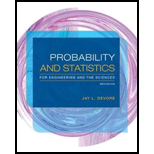
Reconsider the CI (7.10) for p, and focus on a confidence level of 95%. Show that the confidence limits agree quite well with those of the traditional interval (7.11) once two successes and two failures have been appended to the sample [i.e., (7.11) based on x + 2 S’s in n + 4 trials]. [Hint: 1.96 ≈ 2. Note: Agresti and Coull showed that this adjustment of the traditional interval also has an actual confidence level close to the nominal level.]
Show that the 95% large sample confidence interval of population proportion
Answer to Problem 27E
The 95% large sample confidence interval of population proportion
Explanation of Solution
Calculation:
Critical value:
For 95% confidence level
Hence, cumulative area to the left is,
From Table A3 of the standard normal distribution in Appendix, the critical value is 1.96.
Here the critical value 1.96 is approximately equal to 2.
Thus, the critical value
The 95% large sample confidence interval of population proportion is
Point estimate of population proportion:
The point estimate of population proportion is obtained as follows:
The general formula for the estimate of population proportion is
Now, the point estimate reduces as follows:
Thus, the point estimate of the large sample population proportion at 95% confidence level is
Margin of error for confidence interval:
The margin of error for each confidence interval
Thus, the margin of error for each confidence interval
Here, the point estimate is
Therefore, the large sample interval of population proportion is,
Substituting
Thus, the95% large sample confidence interval of population proportion
Want to see more full solutions like this?
Chapter 7 Solutions
Bundle: Probability and Statistics for Engineering and the Sciences, 9th + WebAssign Printed Access Card for Devore's Probability and Statistics for ... and the Sciences, 9th Edition, Single-Term
- Q2-The following values are results for determination of acetaminophen (in mg) in ten separate tablets of Excedrin extra strength pain reliever. Report the mean, standard deviation, relative standard deviation %, median, variance, confidence intervals at t 2.267 224.3. 240.4. 246.3. 239.4. 253.1. 261.7. 229.4, 255.5. 235.5. 249.7arrow_forwardWhat price do farmers get for their seedless watermelon crops? In a recent month, a simple random sample of 31 farming regions gave a sample mean of $12.15 per 100 pounds of seedless watermelon. Assumer that σ=$1.46 per 100 pounds. Find the sample size necessary for a 90% confidence level with a margin of error E=0.61 for the mean price per 100 pounds of seedless watermelon. (Increase to the next whole number.)arrow_forwardLet p equal the proportion of letters mailed in the Netherlands that are delivered the next day. Suppose that y=284 out of random sample n=400 letters were delivered the day after they were mailed. Find an approximate 95% confidence interval of p.arrow_forward
 MATLAB: An Introduction with ApplicationsStatisticsISBN:9781119256830Author:Amos GilatPublisher:John Wiley & Sons Inc
MATLAB: An Introduction with ApplicationsStatisticsISBN:9781119256830Author:Amos GilatPublisher:John Wiley & Sons Inc Probability and Statistics for Engineering and th...StatisticsISBN:9781305251809Author:Jay L. DevorePublisher:Cengage Learning
Probability and Statistics for Engineering and th...StatisticsISBN:9781305251809Author:Jay L. DevorePublisher:Cengage Learning Statistics for The Behavioral Sciences (MindTap C...StatisticsISBN:9781305504912Author:Frederick J Gravetter, Larry B. WallnauPublisher:Cengage Learning
Statistics for The Behavioral Sciences (MindTap C...StatisticsISBN:9781305504912Author:Frederick J Gravetter, Larry B. WallnauPublisher:Cengage Learning Elementary Statistics: Picturing the World (7th E...StatisticsISBN:9780134683416Author:Ron Larson, Betsy FarberPublisher:PEARSON
Elementary Statistics: Picturing the World (7th E...StatisticsISBN:9780134683416Author:Ron Larson, Betsy FarberPublisher:PEARSON The Basic Practice of StatisticsStatisticsISBN:9781319042578Author:David S. Moore, William I. Notz, Michael A. FlignerPublisher:W. H. Freeman
The Basic Practice of StatisticsStatisticsISBN:9781319042578Author:David S. Moore, William I. Notz, Michael A. FlignerPublisher:W. H. Freeman Introduction to the Practice of StatisticsStatisticsISBN:9781319013387Author:David S. Moore, George P. McCabe, Bruce A. CraigPublisher:W. H. Freeman
Introduction to the Practice of StatisticsStatisticsISBN:9781319013387Author:David S. Moore, George P. McCabe, Bruce A. CraigPublisher:W. H. Freeman





